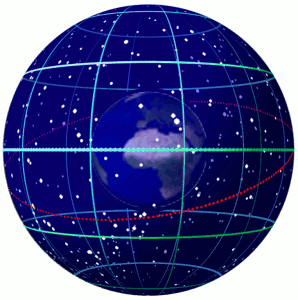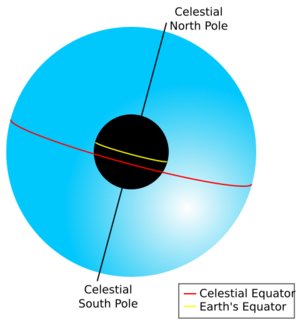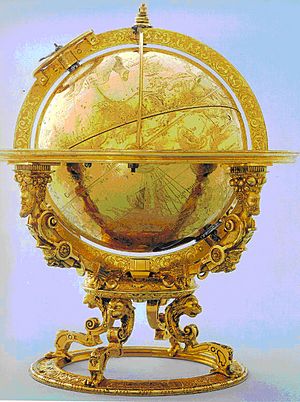Celestial sphere facts for kids
Imagine a giant, invisible ball surrounding our Earth. This is called the celestial sphere. It's an important idea in astronomy and navigation. Even though it's not real, it helps us understand where everything in the sky is.
Think of it like this: Our Earth is right in the middle of this huge imaginary ball. Everything we see in space – the stars, the planets, the Moon, and the Sun – seems to be "drawn" or "projected" onto the inside surface of this sphere. It's a super useful tool for figuring out the positions of things in space.
Contents
Celestial Hemispheres: Splitting the Sky
Just like the Earth is divided into the Northern and Southern Hemispheres by the equator, the celestial sphere is also split in half. We do this by imagining the Earth's equator stretching out into space.
This creates two halves:
- The north celestial hemisphere
- The south celestial hemisphere
You can also find other important imaginary lines and points on this sphere. These include the North Celestial Pole and the South Celestial Pole, which are directly above Earth's North and South Poles.
Sidereal Time: The Stars' Own Clock
Our Earth spins around its axis from west to east. It takes a little less than 24 hours to complete one full spin. Because of this, it looks like the entire celestial sphere, with all its stars, is spinning around us from east to west. This daily movement is called diurnal motion.
This is why stars appear to rise in the east and set in the west. (Unless they are circumpolar stars, which just circle around the pole and never set!)
If you watch a specific star, you'll notice it rises almost 4 minutes earlier each night. Why does this happen?
- Our normal clocks measure a 24-hour day based on the Sun. This is called solar time.
- The Sun actually moves a little bit each day across the celestial sphere. It travels along a path called the ecliptic. It takes the Sun about one year to complete this path.
- Because the Sun moves, we need an extra 4 minutes of Earth's spin for the Sun to appear in the same spot in the sky each day.
Astronomers often use a different kind of time called sidereal time. A sidereal day is how long it takes for the Earth to complete one full rotation relative to the distant stars. This is about 23 hours and 56 minutes in solar time. It's like the stars have their own clock!
Star Globes: Models of the Sky
Sometimes, the term "celestial sphere" can also mean a physical model. These models are like globes, but instead of showing Earth's surface, they show the constellations and stars.
These "star globes" map the constellations on the outside of a sphere. This means they show the constellations as a mirror image of how we see them from Earth. The oldest known star globe is part of a sculpture called the Farnese Atlas. It was made around 120 BC.
Images for kids
-
Celestial Sphere, 18th century. Brooklyn Museum.
See also
 In Spanish: Esfera celeste para niños
In Spanish: Esfera celeste para niños





